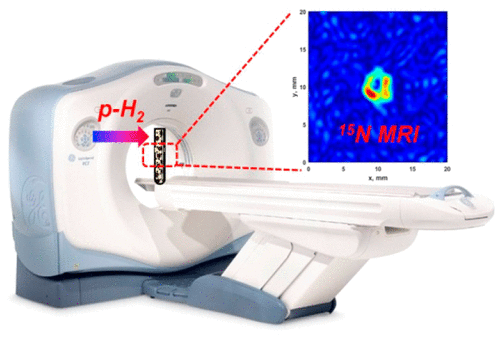当前位置:
X-MOL 学术
›
J. Phys. Chem. C
›
论文详情
Our official English website, www.x-mol.net, welcomes your
feedback! (Note: you will need to create a separate account there.)
Imaging of Biomolecular NMR Signals Amplified by Reversible Exchange with Parahydrogen Inside an MRI Scanner
The Journal of Physical Chemistry C ( IF 3.3 ) Pub Date : 2017-11-14 00:00:00 , DOI: 10.1021/acs.jpcc.7b10549 Kirill V. Kovtunov 1, 2 , Bryce E. Kidd , Oleg G. Salnikov 1, 2 , Liana B. Bales , Max E. Gemeinhardt , Jonathan Gesiorski , Roman V. Shchepin , Eduard Y. Chekmenev 3 , Boyd M. Goodson , Igor V. Koptyug 1, 2
The Journal of Physical Chemistry C ( IF 3.3 ) Pub Date : 2017-11-14 00:00:00 , DOI: 10.1021/acs.jpcc.7b10549 Kirill V. Kovtunov 1, 2 , Bryce E. Kidd , Oleg G. Salnikov 1, 2 , Liana B. Bales , Max E. Gemeinhardt , Jonathan Gesiorski , Roman V. Shchepin , Eduard Y. Chekmenev 3 , Boyd M. Goodson , Igor V. Koptyug 1, 2
Affiliation

|
The signal amplification by reversible exchange (SABRE) technique employs exchange with singlet-state parahydrogen to efficiently generate high levels of nuclear spin polarization. Spontaneous SABRE has been shown previously to be efficient in the milli-Tesla and micro-Tesla regimes. We have recently demonstrated that high-field SABRE is also possible, where proton sites of molecules that are able to reversibly coordinate to a metal center can be hyperpolarized directly within high-field magnets, potentially offering the convenience of in situ hyperpolarization-based spectroscopy and imaging without sample shuttling. Here, we show efficient polarization transfer from parahydrogen (para-H2) to the 15N atoms of imidazole-15N2 and nicotinamide-15N achieved via high-field SABRE (HF-SABRE). Spontaneous transfer of spin order from the para-H2 protons to 15N atoms at the high magnetic field of an MRI scanner allows one not only to record enhanced 15N NMR spectra of in situ hyperpolarized biomolecules but also to perform imaging using conventional MRI sequences. 2D 15N MRI of high-field SABRE-hyperpolarized imidazole with spatial resolution of 0.3 × 0.3 mm2 at 9.4 T magnetic field and a high signal-to-noise ratio (SNR) of ∼99 was demonstrated. We show that 1H MRI of in situ HF-SABRE hyperpolarized biomolecules (e.g., imidazole-15N2) is also feasible. Taken together, these results show that heteronuclear (15N) and 1H spectroscopic detection and imaging of high-field-SABRE-hyperpolarized molecules are promising tools for a number of emerging applications.
中文翻译:

通过与MRI扫描仪内的对氢进行可逆交换而放大的生物分子NMR信号的成像
通过可逆交换(SABRE)技术进行的信号放大采用与单重态对氢交换来有效产生高水平的核自旋极化。先前已经证明,自发SABRE在毫特斯拉和微型特斯拉体制中是有效的。最近,我们证明了高场SABER也是可行的,其中能够可逆地与金属中心配位的分子的质子位点可以直接在高场磁体中进行超极化,从而可能提供基于原位超极化的光谱学和无需样品穿梭即可成像。在这里,我们显示了从对氢(para -H 2)到咪唑15 N原子的15 N原子的有效极化转移2和烟酰胺15 N通过高磁场SABRE(HF-SABRE)获得。在MRI扫描仪的高磁场下自旋从对-H 2质子自发转移到15 N原子,不仅可以记录原位超极化生物分子的增强的15 N NMR光谱,而且可以使用常规MRI序列进行成像。实验证明了在9.4 T磁场下空间分辨率为0.3×0.3 mm 2的高场SABRE超极化咪唑的2D 15 N MRI,信噪比(SNR)为〜99。我们发现,1 ^ h MRI原位HF-SABER超极化的生物分子(例如,咪唑15 N 2)也是可行的。综上所述,这些结果表明,高场SABRE超极化分子的异核(15 N)和1 H光谱检测和成像是许多新兴应用的有前途的工具。
更新日期:2017-11-15
中文翻译:

通过与MRI扫描仪内的对氢进行可逆交换而放大的生物分子NMR信号的成像
通过可逆交换(SABRE)技术进行的信号放大采用与单重态对氢交换来有效产生高水平的核自旋极化。先前已经证明,自发SABRE在毫特斯拉和微型特斯拉体制中是有效的。最近,我们证明了高场SABER也是可行的,其中能够可逆地与金属中心配位的分子的质子位点可以直接在高场磁体中进行超极化,从而可能提供基于原位超极化的光谱学和无需样品穿梭即可成像。在这里,我们显示了从对氢(para -H 2)到咪唑15 N原子的15 N原子的有效极化转移2和烟酰胺15 N通过高磁场SABRE(HF-SABRE)获得。在MRI扫描仪的高磁场下自旋从对-H 2质子自发转移到15 N原子,不仅可以记录原位超极化生物分子的增强的15 N NMR光谱,而且可以使用常规MRI序列进行成像。实验证明了在9.4 T磁场下空间分辨率为0.3×0.3 mm 2的高场SABRE超极化咪唑的2D 15 N MRI,信噪比(SNR)为〜99。我们发现,1 ^ h MRI原位HF-SABER超极化的生物分子(例如,咪唑15 N 2)也是可行的。综上所述,这些结果表明,高场SABRE超极化分子的异核(15 N)和1 H光谱检测和成像是许多新兴应用的有前途的工具。











































 京公网安备 11010802027423号
京公网安备 11010802027423号